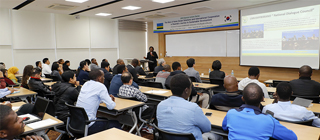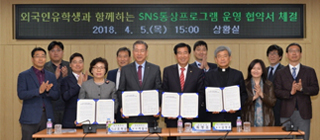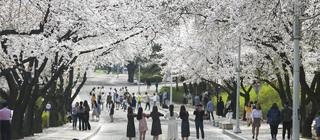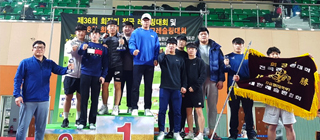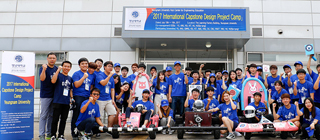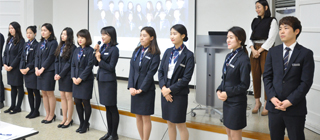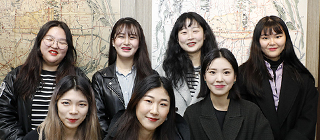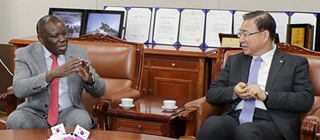-
Part of the ‘invited lecture series’ for international students at the Park Chung Hee School of Policy and Saemaul ‘Development policies and roles of international cooperation for sustainable growth’ “Rwanda’s ‘Umuganda’ similar to Saemaul Undong. Community participates for development” [April 6, 2018] Rwanda Ambassador to Korea Emma Isumbingabo (photo) gave a special lecture at YU. At this special lecture held at the YU Cheonma Art Center Grand Hall Room 307 at 1:30 p.m. on the 6th, over 70 people attended including international students from the YU Park Chung Hee School of Policy and Saemaul, and international students from Rwanda studying at other universities as well. A total of 24 international students from Rwanda graduated from the YU Park Chung Hee School of Policy and Saemaul up until now, and there are also 12 students from Rwanda at YU currently. Under the theme of ‘development policies and the role of international cooperation for sustainable growth in Rwanda’, Ambassador Isumbingabo spoke for about an hour on Rwanda’s development goals and policy directions, the role of international cooperation for the reconstruction of Rwanda, the Rwanda Umunganda Movement, and civic education. During the lecture, Ambassador Isumbingabo said, “’Umuganda’, which is one of Rwanda’s growth policies, has many similarities to Korea’s Saemaul Undong. ‘Umunganda’ refers to ‘working together to achieve a common goal’. Traditionally, family, friends and neighbors worked together to help solve difficult problems in Rwanda. This is similar to the Saemaul spirit of diligence, independence and cooperation.” She added, “Umuganda encourages community members to participate in community work and to bring the community to become one.” This special lecture is the first of the YU Park Chung Hee School of Policy and Saemaul’s invited lecture series. This lecture by the Rwanda Ambassador to Korea was made possible through an international student who was formerly a public employee in Rwanda and is currently studying at the YU Park Chung Hee School. The Park Chung Hee School is planning to hold special lectures on official development aid (ODA), international development cooperation and development experiences by inviting foreign ambassadors to Korea through the invited lecture series. <YU President Sur Gil-soo met with Rwanda Ambassador to Korea Emma Isumbingabo prior to the special lecture.> YU Park Chung Hee School of Policy and Saemaul Dean Kim Gi-soo said, “Being able to listen to lectures from the head of diplomatic envoys, who are in charge of international cooperation and make policies, and sharing the experiences of different countries will be practical and useful education for students majoring in Saemaul international development.” He added, “We will provide various special lecture programs so that Park Chung Hee School students from various countries will be successful as international development and local development after graduating.”
-
YU Professor Ryu Jung-ho’s team’s research results used as cover paper for ‘Energy & Environmental Science’ Succeeded in developing independent power technology for IoT wireless sensors that do not need batteries [April 5, 2018] Technology that uses energy from ‘magnetic field noise’ from electric power lines or around electronic devices’ to convert it to power was developed. The level is at a point that can operate Internet of Things (IoT) sensors, so it can be used in making ‘IoT devices without batteries’ in the future. According to the Ministry of Science and ICT on the 5th, the research results of Professor Ryu Jung-ho (photo, left) of YU, et al were placed on the cover of the April issue of the academic journal, ‘Energy & Environmental Science’. This research took advantage of the fact that because magnetic fields are created in conductors that have electric currents, electromagnetic noises are always generated in power lines or near electronic devices. The research team developed the technology to turn everyday magnetic field changes into electric energy by combining the magnetostriction material gallium-iron alloys and ‘piezo-electric materials’. Magnetostriction materials cause transformations due to changes in the magnetic field or changes the magnetoelectric features by applying pressure. Piezo-electric materials create voltage when pressure is applied or causes transformations when voltage is applied. The researchers used the principle that the properties of magnetostriction and piezo-electric material crystals change depending on the direction of its alignment to produce two materials with directions that change the most sensitively to electromagnetic fields, and the two materials were combined to design materials that maximized energy conversion efficiency. <Conceptual diagram of energy conversion elements used as the illustration for the cover of the April issue of the academic journal ‘Energy & Environmental Science’. This element that YU Professor Ryu Jung-ho, et al developed combines the magnetostriction metal material (bottom) that causes transformations due to magnetic fields and ‘piezo-electric materials (top) that generate electric energy through transformation to convert everyday magnetic field noises into electric energy. April 5, 2018 [Source: Ministry of Science and ICT]> New functions are added to the border (interface) created between the two or more materials to apply the ‘hybrid interface combination’ technology that adds various features. Through this, the researchers succeeded in generating DC power exceeding mW (milliwatt) that is the amount needed for constant operation of IoT remote sensors without batteries. Global Frontier Hybrid Interface Materials Director Kim Gwang-ho and Professor Ryu Jung-ho procured patent rights for the relevant technologies in Korea, USA, Europe, Japan and China. Professor Ryu emphasized, “We have reached a level to semi-permanently operate remote sensor networks, which required batteries until now, without batteries, so we expect that it will be used in wide ranges as an independent power source for wireless sensor networks for the future 4th industrial revolution.” In particular, it is expected that for wireless sensor IoT networks that diagnose the structural integrity of high voltage power sensors including power transmission, hydroelectricity and distribution, independent power sources based on this technology can be applied immediately. The MSIT estimates that a market worth about 350 billion won will be created. This technology can also be used for real-time diagnosis of transportation devices, smart buildings and power infrastructure. This research was conducted with the support of the Creative Convergence Research Project and the Materials Research Center Project centering on the MIST Global Frontier Project.
-
MOU signed between 3 universities in the region (YU, Daegu Catholic University and Daegu University and Gyeongsan City Operating SNS commerce program with international students Engage in various activities such as going to overseas business trips, interpretation and translation, SNS experience posts, etc. from May [April 6, 2018] YU (President Sur Gil-soo) will work with other local universities to help local universities in export operations. YU signed an MOU for ‘SNS commerce program with international students’ to utilize the international student pool together with Daegu Catholic University, Daegu University and Gyeongsan City at the Gyeongsan City Hall Situation Room on the 5th. The ‘SNS commerce program with international students’ is a 1:1 matching project for companies and international students based on data collected through surveys. With this MOU, the institutes agreed to ▲create an environment for export operations support by excellent international students ▲co-hosting education and training programs ▲promoting products of local companies through SNS, etc. The three universities including YU and Gyeongsan City will recruit and select international students and provide training programs related to international trade and begin various activities with companies from May such as joining overseas business trips, interpretation and translation, and SNS experience posting through 1:1 matching. YU President Sur Gil-soo said, “This MOU will be an opportunity for international students to also play a role in local development as members of the community,” and added, “I hope that this will be a win-win program for international students to gain practical experience and companies to enhance their competences for growth with the community.”
-
-
-
First place overall by winning 2 golds, 3 silvers and 3 bronze medals Park Cheol-woong wins MVP and Kim Ik-hee wins best coach awards Won overall first place at the 28th Fall Wrestling Tournament becoming the top collegiate wrestling team [March 21, 2018] The YU wrestling team (Coach Kim Ik-hee) won overall first place at the 36th National Wrestling Championship The YU wrestling team won a total of eight medals including two golds, three silvers and three bronze medals in the collegiate section of the championship at the Cheorwon Gymnasium in Gangwon-do from the 15th to the 18th to place first overall. At this tournament, Park Cheol-woong (21, College of Special Physical Education senior, 97kg) and Kim Yong-hak (20, College of Special Physical Education junior, 74kg) won gold medals, Kim Jong-won (20, Sports Science senior, 86kg), Park Chang-hwan (19, College of Special Physical Education sophomore, 92kg) and Gong Ji-min (18, Sports Science freshman, 61kg) won silver medals, and Kim Sung-soo (20, College of Special Physical Education senior, 125kg) Ahn Jae-yong (20, Sports Science junior, 57kg) and Han Hyun-soo (19, College of Special Physical Education sophomore, 125kg) won bronze medals. Park Cheol-woong, who won the gold medal in the 97kg and under division, received the MVP, while YU Wrestling Team Coach Kim Ik-hee won the Best Coach Award for his efforts to win overall first place. The YU Wrestling Team also swept a total of eight medals such as four golds, one silver and three bronze at the 28th National Fall Wrestling Tournament to take overall first place. At the most recent championships, it maintained its position as the best collegiate wrestling team. Coach Kim Ik-hee who brought the glory days of the YU wrestling team said, “I would like to thank the athletes who persevered and trusted me despite the harsh schedule of matches and training.” He added, “We will continue to do our best in training to achieve even more than we already have.”
-
Ministry of Trade, Industry and Energy’s ‘Support project for fostering creative convergence engineering human resources’ To foster engineers with national funding of a total of 1.2 billion won for four years until February 2022 Foster engineers who will lead the 4th industrial revolution in ICT, smart vehicles and IoT convergence [March 29, 2018] <‘2017 International Capstone Design Project Camp’ hosted by the YU Engineering Education Innovation Center> YU (President Sur Gil-soo) was selected for the ‘Engineering Education Innovation Center’ (formerly Engineering Education Innovation Hub Center’ for the Ministry of Trade, Industry and Energy’s support project for fostering creative convergence engineering human resources’. By being selected for this project, YU will receive a total of 1.2 billion won in national funding for four years – 300 million won per year – from this year until February 2022 to focus on fostering engineers. A total of six universities were selected such as YU, Korea University, Pusan National University, Seoul National Institute of Science and Technology, Sungkyunkwan University and Chonbuk National University. YU has been pursuing the Engineering Education Innovation Center project that began in 2012 for the sixth year, and with this selection, it will pursue this project for a total of 10 straight years. <YU took the grand prize in the University of the Year Award held at the ‘2016 Engineering Education Festival’> YU Engineering Education Innovation Center Director Song Dong-joo (Professor of Mechanical Engineering) explained, “A systematic engineer fostering system is needed to improve innovative and creative problem-solving skills in order to empower engineering students, and our center will be in charge of this.” He added, “YU is planning to foster engineering students who will lead the 4th industrial revolution by developing and operating educational programs according to the needs of the core industries of the future.” The YU Engineering Education Innovation Center is planning to operate educational courses and industry-academic cooperation education specialized for the new industries of the future such as ICT (information communication technology), smart cars and IoT (Internet of Things) convergence, while pursuing holding various contests, international Capstone design project camps, engineering festivals, etc. to meet the demands of businesses. Meanwhile, the MOTIE is pursuing the ‘creative convergence engineer fostering support project’ to foster creative engineers to meet the demands of industries and improve the global competitiveness of engineering education. As part of this, the Engineering Education Innovation Center project is joined by universities in different regions centering on the regional hub university. A total of 18 universities (as of Feb 2018) in the Gangwon, Chungcheong, and Gyeongsang regions will participate in the YU Engineering Education Innovation Center, which is the highest number of colleges in the nation, and it is playing a centrifugal role for domestic engineering education.
-
-
YU Art Conservation major students draw attention by restoring two artifacts in the university museum Only 20 students in the entire class with professional skills participating in restoration work of collections of the National Museum Must complete 5 different majors. Difficult but promising as a professional field [March 13, 2018] <YU Major of Art Conservation students> (top row from left to right: Lee Ok-seon, Kim Hye-bein, Kim Young-won, Park Shi-eun, bottom row from left to right: Lee Hye-mi, Lim Ji-soo, Lee Yun-ah) Our proud cultural heritages were reborn at the hands of YU students. YU Major of Art Conservation interdisciplinary students (supervised by School of Fine Arts, Advisor Lim Nam-soo) restored two artifacts at the YU Museum. The pieces are ‘Doseongdo’ (early 19th century), which is a painted map of Seoul in the late 18th century, and a eight-screen folding door painting comprised of stationery paintings. This exhibit is the result of the ‘Painting Preservation and Restoration Training Class (Professor Jung Doo-hee)’, which is a major class for the second semester of last year. The restored work was put on display on the 1st floor lobby of the Central Library from March 5 to March 9, drawing the attention of students. <Original (left) and restored work (right) of the ‘Doseongdo (YU Museum Collection, early 19th century) restored by Art Conservation majors> YU School of Fine Arts senior Park Shi-eun (21, interdisciplinary study major in art conservation), who participated in the restoration project, said, “A lot of work and time is needed to make a restored version as it is necessary to conduct research on the original and completely reproduce even the smallest details.” She added, “We carefully restored the damaged parts of the cultural artifact and configured the colors exactly like the original with natural pigments. In particular, as several people worked together taking on different roles and later combine the piece, teamwork was crucial.” The YU Major of Art Conservation is a small group of elite students. There are only 20 persons in the entire grade, but their skills are on par with professionals. They also participated in various restoration projects at national museums. They have been recognized for their skills and even participated in the restoration of project of a portrait of King Gojong (collection of the National Museum of Korea) at the request of the National Palace Museum of Korea. They also participated in the restoration of a 4 meter long farm flag at the National Maritime Museum in Busan, and the work that they restored was used at the Haeshinje Festival. <Production process of the restored version of the 'Doseongdo' (YU Museum)> School of Fine Arts Professor Lim Nam-soo who is the head professor of the major said, “Experience with restoring paintings and historical artifacts of various genres is very important. It is possible to vastly improve skills by looking at valuable cultural artifacts possessed by the National Museum and the university and have the opportunity restore them.” He added, “Most students majoring in art conservation work by looking at books or digital files. YU students, however, have the educational infrastructure in which they can see the actual piece to work on them, which will help improve their skills significantly.” YU School of Fine Arts senior Kim Hye-bin (22, interdisciplinary major in Art Conservation) said, “I was able to see the original several times while working on it. Originals and photos have considerable differences, so it is only obvious that there will be differences in the restored work. Being able to see the actual piece was really helpful.” <Stationery painting restored by students majoring in art conservation> The major of art conservation is an interdisciplinary course combining the five majors of the School of Fine Art’s major of painting and major of transart, as well as the School of Materials Science and Engineering, Department of Fiber System Engineering, and the Department of Forest Resources and Landscape Architecture. This program was newly established in 2016 and there are currently 20 students in the interdisciplinary major course. These students will prepare to acquire cultural artifact repair technician copying technician. After graduating, career options include becoming a preservation and restoration expert at museums and art galleries. YU School of Fine Arts senior Kim Young-won (21, interdisciplinary major of art conservation) said, “It is important to base the foundation on examining the original and working on site. It is not just copying an original piece, but instead, preparations such as understanding the artist’s style and collecting data on the work are crucial. Furthermore, the genres of cultural artifacts and art pieces are very diverse. It is also important to identify the properties of the materials for the preservation and restoration of various artworks and craftwork such as architecture, sculpturing, crafts and painting. It is difficult and that is why knowledge on various majors is needed.” Professor Lim said, “Paintings usually is on making creative pieces. Art conservation deals with various fields starting from creation to follow-up such as conservation and restoration and thus requires integrated knowledge on various majors, therefore giving it bright prospects as a professional field.” Professor Jung Doo-hee, who is in charge of the painting preservation and conservation class, said, “The YU Museum possesses many cultural artifact-level relics such as ancient maps. I suggested to the museum that it would be meaningful to do restoration work on the artifacts possessed by the university and that it would help students, and the museum agreed happily.” He added, “We will continue the restoration projects on our artifacts with students in our major by working with the library and museum in the future.”
-
International student of Park Chung Hee School of Policy and Saemaul international returned to Tanzania after graduating and became a governor Recently visited YU and Gyeongsan City with businessmen asking to help develop Tanzania Pursuing positive exchange in various fields including government, academic and industries [March 7, 2018] A Tanzanian graduate of the YU Park Chung Hee School of Policy and Saemaul became mayor back at his home country and returned to YU. Matthew N. Lubongeja (53) of the Sengemara District, Tanzania, came to learn the know-how of YU using Korea’s economic development experience as the role model for its development. On February 27, Mayor Lubongeja visited YU together with Tanzanian businessmen including Jonta Investment Limited Chairman John Elias Ntalimbo and met with YU President Sur Gil-soo requesting YU’s assistance for the development of Tanzania. Mayor Lubongeja enrolled at the YU Park Chung Hee School of Policy and Saemaul in September 2016 and earned his master’s degree in February 2018. Mayor Lubongeja was the vice-mayor at the time he enrolled at the graduate school. Mayor Lubongeja said, “The experience that I gained at the YU Park Chung Hee School of Policy and Saemaul played a decisive role for me to become mayor.” He added, “I was deeply impressed with Korea’s development based on the Saemaul Undong that I learned at YU. The first thing that I thought about after becoming mayor was to integrated Korea’s economic development policies and know-how into Tanzania to make my country economically strong just like Korea. I have come to YU with Tanzanian businesspeople to learn about this know-how.” YU President Sur Gil-soo said, “The Saemaul Undong and spirit acted as the driving force for Korea’s rapid development. YU established an academic system in various fields such as international development based on the Saemaul science.” He added, “The academic knowledge and know-how accumulated by YU will help the development of not only Tanzania, but other developing countries around the world as well.” While meeting with Mr. Sur, Mayor Lubongeja proposed exchange cooperation with Tanzanian universities such as the Sokoine University of Agriculture and St. Augustine University of Tanzania. In response to Mayor Lubongeja’s proposals, YU is planning to pursue international cooperation projects such as jointly carrying out education to transmit the Saemaul Undong and Saemaul spirit as well as regional development projects. Businessmen from Tanzania that visited YU together with Mayor Lubongeja showed deep interest in YU’s educational mission and the academic program of the Park Chung Hee School of Policy and Saemaul, and said in unison, “If youths from Tanzania come study at YU to gain knowledge and experience, it will help greatly with the development of Tanzania.” Mayor Lubongeja not only visited YU, but also Gyeongsan City, where YU is located, to discuss making friendly relations with Gyeongsan Mayor Choi Young-jo. Mayor Lubongeja revealed that he would like to pursue exchange focusing on the advanced agricultural technologies of Gyeongsan and dispatch a public official of Sengemara to Gyeongsan to learn the advanced agricultural technologies. Mayor Lubongeja’s visit to YU and Gyeongsan received huge attention from the Tanzanian press as well (left on photo, press coverage in Tanzania, link:https://globalpublishers.co.tz/kampuni-za-tanzania-korea-zasaini-ushirikiano-katika-ujenzi). This is because he believes that exchange with YU will help with the development of Tanzania. As an international student of the YU Park Chung Hee School of Policy and Saemaul became a governor at his home country and is actively pursuing exchange with various Korean institutes together with Tanzanian public officials, scholars and entrepreneurs, it is expected that the social and economic ripple effect will be considerable for both countries.
